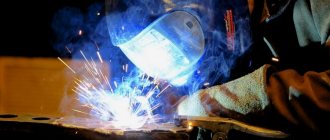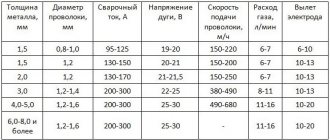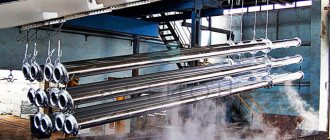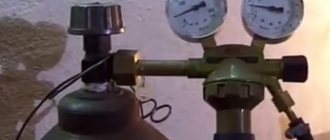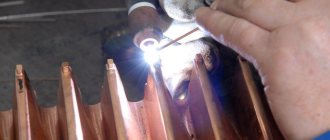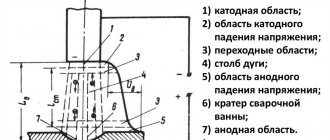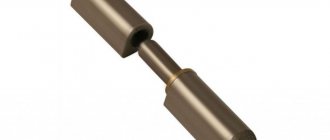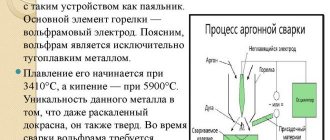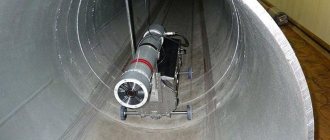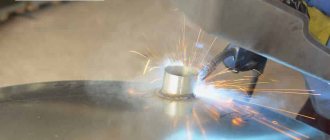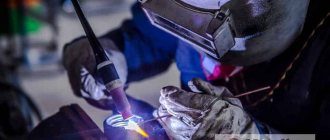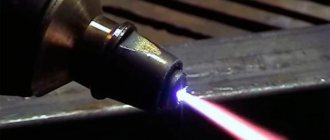What is electric arc welding
It is important to know what electric arc welding is. During this technological process, the adjacent areas of the two elements being welded are melted using the heat that comes from the electric arc. The weld pool moves behind the electric arc. And when it hardens, it turns into a state of a strong and permanent connection, which is also called a weld.
The technology of electric arc welding of metals has a characteristic feature. The molten metal base is capable of intense interaction with atmospheric oxygen and nitrogen.
In order to protect the weld pool, the following types of gases are usually used:
- Argon;
- Carbon dioxide;
- Helium and other inert gases.
It is worth noting! Electric arc welding can be carried out using consumable electrodes, the material of which will be included in the weld, as well as non-consumable ones. In these situations, flux additives are poured along the joint line in powder form.
Features of MMA inverters
Among the best welding machines there are many inverter-type models. This technique produces welding by changing the electrical characteristics several times. First, a current with a frequency of 50 Hz enters the rectifier, where it becomes constant. Then the transistors convert the current back into alternating current, but its frequency increases to 20-50 kHz. Next, using a transformer, the current is given a voltage of 70-90 V and the current increases to 100 -200 A. The last stage is a rectifier and a high-frequency filter, thanks to which the electric current becomes constant and in this form is supplied to the place where the arc is formed.
Despite the fact that inverters began to be mass produced only in the 80s. twentieth century, they are very popular at the present stage. The reason for this is their following advantages:
- Welding current is adjustable over a wide range.
- Can be connected to a household electrical outlet.
- Low energy consumption with high performance (efficiency - 85% and above).
- Smooth voltage and current regulation.
- Possibility to weld for a long period of time without turning off the device.
- Welding is carried out in all positions, with almost no metal spattering.
- Arc stability.
When planning to choose an inverter-type welding machine, please note that it still has disadvantages:
- High cost of the device and its components.
- It is necessary to protect the device from exposure to dust and moisture, periodically clean it with a soft brush and an air stream.
- Despite the fact that the best manufacturers declare that their welding devices are frost-resistant, inverters are more likely to fail at temperatures of -15 degrees Celsius and below.
How to choose a welding inverter can be found here.
Principle of electric arc welding
There are several principles in electric arc welding technology - short circuit and breakdown. It is the last indicator that deserves special attention.
In this case, the basis is the breakdown of the dielectric, which occurs when the interatomic space is filled with particles with an electric charge. Ions create positive charges, and electrons create negative charges. In some situations, breakdown is possible for any dielectric. But as for electric arc welding of metals, during it a breakdown of the air space between the electrode and the mass is used.
During welding, a current charge is created on the electrode with a low voltage, but with high strength - approximately 80-200 A. A huge density is also observed - several thousand A / m2.
At the moment the electrode touches the mass, namely another material with high electrical conductivity when welding metal structures, a short circuit may occur, which creates an electric field with high power. This is where the breakdown occurs.
Types and methods
Electric arc welding has several varieties. Each of them has some distinctive features that affect the quality and type of welded joint. The following types of electric arc welding are distinguished:
- Manual electric arc welding. During it, only human manual power is used without mechanisms;
- Mechanized type. During the process, mechanization is used to feed wire into the welding area, and part of the work is done by manual force;
- Automatic type. Welding is carried out automatically. Special equipment independently feeds the arc, regulates its length and movement.
The technological process of electric arc welding is also divided into methods:
- In a bun . During welding, several electrodes are bundled together, their ends are welded and installed in a holder. A larger range of currents is used and you can independently increase performance indicators.
- Welding with a lying electrode . During this process, laying can be done with a length of 50 to 120 cm with coating in a cut joint or corner. A copper bar with a longitudinal groove is placed on it. After this, the workpiece and electrode are connected to a current source. The carbon rod ignites an arc that goes under the bar area. It moves along the joint, melts the working element and welds the edge. The result is a welded joint.
- Welding with an inclined electrode . This method is carried out to improve productivity. During this process, the electrode is fixed in a clamp with a holder, which moves under its weight along the stand. At the moment the arc is ignited, the electrode melts and the holder falls down.
Purpose of the electrode
Table of types of electrodes for welding.
By purpose, electrodes are divided into:
- working with steels with high levels of alloying elements;
- with an average content of alloying elements;
- welding of structural steels;
- ductile metals;
- surfacing;
- heat-resistant steels.
Thus, it is possible to select electrodes for each specific task.
Special attention should be paid to the protective coating. Coating of electrodes is an important component that has special requirements. In addition, it is characterized by a certain composition.
They are a rod covered with a special shell. The power depends on what diameter it has.
The most popular are UOSI electrodes. There are several brands of this material and all of them are used for manual welding.
UONI 13-45 allows you to obtain seams of acceptable viscosity and ductility. They are used for welding during casting and forging. These rods contain nickel and molybdenum.
UONI 13-65 are suitable for work on structures with increased requirements. They can make connections in any position. The diameter varies from two to five millimeters; the larger it is, the greater the welding current.
In most characteristics, these rods are similar to each other. They can function at low temperatures, while providing a reliable tight seam with high mechanical parameters.
In addition, the compounds obtained with their help are characterized by high impact strength and cracks do not form in them. All this makes them the most promising for working with critical structures that are subject to stringent requirements.
In addition, these structures are resistant to temperature changes, vibrations and loads. An important feature of rods of this type is significant resistance to moisture and the possibility of long-term calcination.
Types of coating
Electrode coatings include the following components:
- deoxidizers;
- components for stable arc burning;
- elements that provide plasticity, such as kaolin or mica;
- aluminum, silicon;
- binders.
All coated electrodes for spot or manual welding are subject to a number of requirements:
- high efficiency;
- the ability to obtain results with the required composition;
- minor toxicity;
- reliable seam;
- stable arc burning;
- coating strength.
Types of electrode coating.
The following types of electrode coatings are distinguished:
- cellulose;
- sour;
- rutile;
- basic.
The first type allows you to perform work in all spatial positions with direct and alternating current. They are most widely used in installation. They are characterized by significant losses due to splashing and do not allow overheating.
Rutile and sour allow you to cook in all positions except vertical, with direct and alternating current. The second type of coating is not suitable for working with steels with high sulfur and carbon content.
The base coating is applicable for forming thick metal joints using direct current of reverse polarity. It also does not allow working in a vertical position from top to bottom.
The types of shells listed above imply the use of only one specific type of coating. However, combinations of several options are possible. Combinations can consist of several types depending on the problem being solved.
Combined shells belong to a separate class and are not classified among the main four types.
There is also a classification depending on the thickness of the coating.
Each thickness is assigned a separate letter designation:
- thin - M;
- medium thickness - C;
- thick - D;
- especially thick G.
Of course, the rods are selected in accordance with the goals set. The right choice guarantees high quality of work performed.
https://youtu.be/AvCg7p3no98
Electrode brands
Decoding the electrode markings.
There are different brands of electrodes designed to solve specific problems. They are characterized by certain properties, which allows you to select the most suitable material.
Grade OK-92.35 is characterized by an elongation of sixteen percent and a yield and strength strength of 514 MPa and 250 HB, respectively. The yield strength of OK-92.86 is 409 MPa.
Electrode grades for manual welding OK-92.05 and OK-92.26 have a relative elongation of 29% and 39%, and a yield strength of 319 and 419 MPa, respectively.
The yield strength of OK-92.58 is 374 MPa.
All of the above electrodes are used for manual arc welding on cast iron. Depending on what metal is to be worked with, a special type of rod is also selected. For example, for copper - ANTs/OZM2, pure nickel - OZL-32, aluminum - OZA1, monel - V56U, silumin - OZANA2, etc.
All electrodes must comply with GOST standards. This will determine the quality and reliability of the work performed.
In addition, the welder also needs to control the quality of the parts being welded. Depending on the material, operating conditions, position of the seam and other factors, select the appropriate electrode that will ensure the best quality of connection.
Types of devices
Typically, when carrying out electric arc welding, a simple welding machine is used - a transformer one. It works on the principle of a conventional transformer, lowering the voltage and increasing the current. This device cooks using alternating current.
However, transformer welding equipment is inconvenient and huge in size. For this reason, problems may arise with its movement. For these purposes, a special device on wheels is required.
If you need a mobile welding machine for electric arc welding, then an inverter is an excellent option. This equipment first converts alternating current from the household network into high-frequency current. And after that it converts it to permanent. In addition, devices of this type are lightweight and compact in size.
Inverter arc welding equipment helps achieve maximum arc stability. This is what has a positive effect on the quality of the seam. In addition, the device allows you to use different modes - with direct and reverse polarity.
The best welding machines for manual MMA arc welding
Having considered the key characteristics, it will be easier for you to choose a device for the upcoming tasks. Next, we present a rating of the best models that have received the largest number of positive customer reviews. Perhaps among them you will find one that suits your needs.
The best MMA welding machines for 140-200 A
Transformers and inverters rated at 140-200 A are household models that are used in the country, in the courtyard of a private house, or in the garage. They are suitable for a small private workshop. They are called household because of their connection to a 220 V network and the ability to weld only thin iron up to 4-5 mm in cross-section. Here is a ranking of the best models in this category.
RESANTA SAI-140
Welding machine from a domestic manufacturer. The current range is 10-140 A. There is a rotary regulator with a drawn scale. Two indicators on the case indicate network connection and overheating. The inverter casing is entirely made of steel, which protects internal parts from shock. The 75V idle makes it easier to ignite the electrode. At maximum PV current, 70% is acceptable. The housing has a degree of protection IP21. The wide shoulder strap makes it easy to transport and work at heights. This is quite possible since the inverter weighs 4.3 kg.
Watch the product video
+ Pros of RESANTA SAI-140
- Full metal body.
- Comfortable shoulder strap.
- There are two additional functions (“Anti-stick” and “Hot start”).
- Easy ignition of the electrode.
- Weighs 4.3 kg.
- You can cook from a gas generator with a power of 3 kW.
— Disadvantages of RESANTA SAI-140
- No display.
- You can cook maxima with an electrode 3 mm in diameter.
- Flimsy mass clamp and holder.
- Short cables included.
Conclusion . This is one of the cheapest inverters for manual MMA welding. Its cost is explained by its simple configuration and maximum welding current of 140 amperes. The unit is notable for its ability to weld at a reduced voltage of 140 V. If your power line is weak, then this is the best option.
PATRIOT Max Welder DC-200
Second place in the ranking is given to an American brand produced in China. The inverter has a current of 10-200 A and an open circuit voltage of 75 V. A wheel and a drawn scale are provided to adjust the welding current. The front panel is equipped with two indicators that indicate connection and overheating. The device can be carried using a wide strap, which is not difficult to do with a weight of 4.5 kg. The holder included in the kit is equipped with multi-position copper plates for clamping the electrode at different angles.
Watch the product video
+ Pros of PATRIOT Max Welder DC-200
- The weight of the unit is 4.5 kg.
- Welding wire with a cross section of 25 mm².
- Compact dimensions 300x120x190 mm.
- Easy ignition of the electrode.
- Three additional functions at once.
- It works very quietly.
— Cons of PATRIOT Max Welder DC-200
- Sold without case.
- Short wires 1.8 m each.
- No screen for visual control of settings.
- The front and back walls of the case are made of plastic.
- Flimsy holder.
- The “crocodile” mass has a small contact area and heats up.
Conclusion. This is one of the best household-class devices in terms of price and performance. It is suitable for manual welding with electrodes up to 5 mm in diameter. Not every model is capable of this. The increased power allows you to use the inverter for welding gate hinges, greenhouse frames, and gazebos. They will also be able to cut a corner using electric welding, which does not require additional tools (grinders, hacksaws).
Features of the work
Electric arc welding of cast iron and other types of metal must be carried out correctly. Compliance with all principles and rules will allow you to obtain a strong and high-quality weld.
Manual electric arc welding technology includes several features:
- At the initial stage, the workpieces are cleaned and degreased, and they can be cut. You need to attach a hot electrode to them. The end part of the electrode divides the surface area of the element being welded into ions and electrons;
- In order for welding to be faster and the result to be of high quality, special elements should be applied to the surface of the welded material (electrode). It is recommended to use calcium, potassium, sodium. They accelerate the separation of metal into particles;
- The welding process can be carried out using an open or closed arc. When open, a lot of nitrogen will penetrate into the metal base, this will have a detrimental effect on the structure of the weld. To reduce this negative impact, a layer of metal must be applied to the electrodes. In industrial conditions, the best option would be to use a closed method, during which the welding zone will be protected from exposure to oxygen;
- Next, you need to install the electrode in the equipment for electric arc welding - an inverter. Using the end of the rod, you need to pass it twice along the ends of the metal components being welded - this will ignite the arc. After the welding machine is turned on, it is necessary to set the current at the required level;
- During the welding process, the electrode rests on the surface of the parts being welded and is slowly moved across the gap area. Liquid metal enters the weld pool, which, when solidified, forms a strong and even weld. The use of a special technological map will allow you to accurately calculate the power, current and duration of arc exposure;
- Welding of vertical seams is carried out using an arc. The level of the contact angle between the electrode and the surface to be welded must be straight. A slight deviation of 10 degrees is allowed;
- To prevent the deposition of liquid metal in one area, the herringbone, triangle, or multi-layer thin arc technique can be used.
Important! During electric arc welding, the welder must follow all the rules and steps. Each welding method is selected depending on the metal used and the welding conditions (in industrial or domestic conditions).
How to choose a welding machine for manual arc welding
It is necessary to select welding equipment for manual arc welding based on the upcoming tasks of joining metals, including the maximum thickness of the workpieces, the location of work, the volume and type of steel. Here are the key equipment characteristics and recommended values for various activities.
Operating voltage
An important parameter that determines where you can cook with the device:
- Household models for 220 V, which can be connected to regular sockets. Suitable only for welding steel with a cross-section of up to 10 mm.
- Universal models designed for 220 and 380 V. They are suitable for both garages and production. They can weld metal up to 20 mm in thickness.
- Industrial installations with power supply 380-580 V. Designed for joining workpieces with a thickness of 10-50 mm.
Where the voltage often “sags” (a weak power line in a garage cooperative, a remote village, or a country house), it is advisable to choose a welding machine with an input current of 160 V. This will allow manual welding without installing a voltage stabilizer in the circuit.
Welding current adjustment range
The thickness of the penetration depends on the current strength. The adjustment range of some devices is 160-200 A, others 200-250 A. Industrial devices can have a maximum value of 400-500 A. If you buy an inverter with insufficient current reserve, then the metal from the electrode will not be able to fuse inside, but will stick on a surface. Such a seam will be weak and not airtight.
- For welding steel with a cross-section of 1-2 mm, a current of 60-100 A
- To cook workpieces 3-5 mm thick, choose an inverter with a rating of 160-200 A.
- If welding thick parts 6-20 mm is a priority, then a professional machine with a current of 250-400 A
| Metal thickness, mm | Welding electrode diameter, mm | Recommended welding current values, A |
| 1-2 | 1,0 | 20-60 |
| 3-4 | 1,6 | 50-90 |
| 4-5 | 2,0 | 60-100 |
| 5-6 | 2,5 | 80-120 |
| 6-8 | 3,2 | 110-150 |
| 8-11 | 4,0 | 140-180 |
| 12-15 | 5,0 | 180-220 |
| 15-18 | 6,0 | 220-260 |
Duration of activation
This characteristic is denoted by the abbreviation PV and is measured as a percentage. A PV indicator of 40% means that out of 10 minutes, the device will be able to cook at maximum current for 4 minutes continuously, and the rest of the time will be required for cooling. If you need to use the machine for a short time (welding with short seams, where there is often an interruption for subsequent marking and cutting of workpieces), then you can save money and buy a machine with a low duty cycle, since it will have time to cool down during downtime.
In cases of long-term welding, you need to buy an inverter with a duty cycle of 80 or 100%, which will allow you to weld almost without stopping. The second option is to purchase a device with a high maximum current rating (for example, 250 A). And although its duty cycle at maximum will be 40%, but at a value of 160 A, the duty cycle will be 100%. And this is enough for continuous welding of sheet steel with a cross section of 3 mm.
Open circuit voltage
Since the welder often holds or even stands on the workpiece while making a weld, it is necessary to ensure safety from electric shock. To do this, the voltage during arc closure is reduced to 12-48 V. This avoids electric shock. But as long as the arc does not burn (the circuit is open), the idle speed is maintained at higher levels.
This is necessary to make it easier to close the contact and initiate an electric arc. The higher the idle speed, the easier it is to ignite the electrode. This is especially noticeable when welding iron that is rusty or poorly cleared of paint. It is better for a beginner to look for devices with an indicator of 70-90 V. For more experienced welders, 60-70 V is enough.
Power consumption
The value varies in different models from 4 to 20 kVA. This determines how thick the cross-section of the wiring in the supply network should be. If the power of the device is too high for a household outlet, the wiring will melt. Therefore, for a dacha you need transformers with 5-7 kVA. If you plan to carry out welding work in the field using a gas generator, then it is better to find a 4 kVA machine. There are no restrictions for industrial versions, since in factories the connection of powerful equipment is included in the calculations when designing electrical networks.
Protection from dust and moisture
The characteristics of the welding machine indicate the protection of the housing from solid particles and water (IP). The first value is always "2". This means that the housing will not be penetrated by hard parts with a diameter of 12 mm or larger. This means that the jacket will not be sucked in by the fan blade, and your fingers will not get into live parts.
The second value can vary from "1" to "3". In the first case, the device is protected from vertical drops, and in the second from rain, even if the splashes fall at an angle of 60 degrees. If you work under a roof, then this does not matter, but for outdoor activities, IP23 protection will help you complete your work outside, despite the onset of rain.
Ventilation system
All devices for RDS are equipped with ventilation that removes heat from the transformer and board to the outside. The initial system is implemented in the form of a fan and perforations on the case. If it overheats, protection is triggered and the inverter turns off until it cools down. The presence of holes for ventilation leads to the fact that dust is drawn into the housing and periodic blowing is required.
Industrial models may have water cooling. In it, a mixture of alcohol and distilled water circulates through the channels using a water pump. The liquid removes heat from key electrical parts, extending the operating time of the device. But such products are more expensive, so the purchase is justified only by the need to continuously cook for 5-7 hours every day.
Temperature range for operation
If you have to work with manual welding in a heated room, then this characteristic is not important. But for those who work in cold buildings or outdoors, it's worth paying attention to the temperature range. Often, inverters are allowed to be used down to -10 degrees. There are special models that work properly at -20 degrees.
At positive maximum temperatures (which for most models is +40 degrees), the inverter’s thermal protection will work faster. Therefore, it is better to place the device in the shade in a ventilated area, then it will take longer to heat up.
Weight and dimensions
The dimensions and weight of the welding machine affect the mobility of the welder and ease of transportation. For stationary use in a garage or workshop, dimensions and weight are not important. Unless you need to provide space for a device 500x500x600 mm. But for field activities it is worth buying a transformer weighing 3-6 kg. It can be put on the shoulder and cooked at a height, which does not require long cables and a holder, but only an extension cord for the power cord. Dimensions of compact inverters range from 200x120x170 mm.
Availability of additional functions
The more additional functions a welding machine has, the easier it is to carry out manual welding and make a high-quality seam. A beginner should pay special attention to this. Here is a description of some additional capabilities of welding equipment:
- VRD - reduces idle speed to 9-12 V. This is necessary when welding work is carried out inside or on a metal structure to further increase safety. The function is especially useful if welding is performed in a humid environment that increases current conductivity.
- Antistick - switches off the welding current when the electrode sticks. Facilitates the moment of detaching a stuck rod from the product, saves time and simplifies the learning process.
- Hot Start - gives an increased current (voltage V) precisely at the moment of ignition of the electrode. Well suited for hand welding rusty or painted metal. Helps to start a seam in exactly the intended place, without leaving electrical marks from tapping with an electrode on the workpiece.
- Arc Force - at the moment the electrode sticks, gives a short-term increase in current strength (by 10 A) to prevent arc extinction. Useful for manual welding of thin sheet steel.
Video. How to choose a welding inverter for manual arc welding
Security measures
When performing electric arc welding, the following safety precautions must be observed:
- It is imperative to wear protective clothing and shoes made of thick material. These products can protect the body from hot metal, which can cause severe burns. The sleeves must be buttoned tightly, and gloves must be worn on the hands.
- If you don’t have a protective uniform, you can use cotton clothing instead.
- From bright light and sparks from hot metal, your face and eyes must be covered with a protective mask.
- Welding work must be performed in ventilated areas.
- Before starting work, it is recommended to prepare water or a fire extinguisher. Hot metal particles and sparks can lead to a fire, so all means to prevent it should be at hand.
Note! Safety precautions must be strictly observed. If this is not done, you may inadvertently suffer serious injuries during the welding process.
Electric arc welding is a popular technology that is excellent for welding different types of metals. The process must be carried out correctly in compliance with important principles. The work needs to be done in stages, this will allow you to develop an even and durable seam. But don’t forget about the necessary safety measures that will protect you from injury and help you do everything right.
